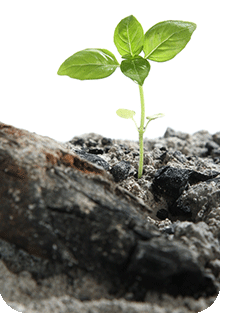This Year's Sustainable "Green" is Black: The Basics of Biochar
Author: Chad Kennedy, Landscape Architect, ASLA
 I sat awestruck as image after image of massive flames and endless smoke plumes filled the screen. The newscaster's reports were not optimistic about an end to the devastation and destruction being caused to one of the Nation's most treasured forests, Yellowstone National Park. As a young boy I vividly remember viewing images of the charred remains, where once magnificent and breathtaking landscapes prevailed, and thinking there was no possible way the area would ever rebound from its desolate state. I was very wrong, and this area has made an amazing recovery since those fires in 1988. At that young age I didn't realize that though devastating, there are some benefits that come from burn events. One such benefit is the return of nutrients to the soil in the form of charred plant material. As the son and grandson of two avid home gardeners I was exposed at a young age to the concept of using ash from fires as a soil amendment for the purposes of increasing yield and plant health. This concept, however, is not new and has been used throughout history, and even by ancient agrarian societies as a method of infusing nutrients back into the soil. In fact over many centuries Tera Preta soils (extremely fertile soils in the amazon basin) were created by native societies who deliberately added char and other organics to the soil.2
I sat awestruck as image after image of massive flames and endless smoke plumes filled the screen. The newscaster's reports were not optimistic about an end to the devastation and destruction being caused to one of the Nation's most treasured forests, Yellowstone National Park. As a young boy I vividly remember viewing images of the charred remains, where once magnificent and breathtaking landscapes prevailed, and thinking there was no possible way the area would ever rebound from its desolate state. I was very wrong, and this area has made an amazing recovery since those fires in 1988. At that young age I didn't realize that though devastating, there are some benefits that come from burn events. One such benefit is the return of nutrients to the soil in the form of charred plant material. As the son and grandson of two avid home gardeners I was exposed at a young age to the concept of using ash from fires as a soil amendment for the purposes of increasing yield and plant health. This concept, however, is not new and has been used throughout history, and even by ancient agrarian societies as a method of infusing nutrients back into the soil. In fact over many centuries Tera Preta soils (extremely fertile soils in the amazon basin) were created by native societies who deliberately added char and other organics to the soil.2
Though not new technology, today's society has indeed developed cleaner and more innovative ways of producing and using what is now commonly referred to as "biochar". The use of biochar has myriad benefits, when properly produced is an amazingly sustainable process, and is fairly simple to produce.
Biochar Benefits
Biochar is a carbon rich product resulting from the burning or heating of organic materials under low temperature and oxygen conditions.3. The product is a charcoal like material that has shown to be effective at and is being used in the following ways:
Animal Farming - Biochar can be used as a feed additive, litter additive, composting ingredient and water treatment for fish farming. 2
Soil Conditioning - When added to the soil, biochar can retain moisture, retain plant sustaining nutrients and improve water quality . When used as a supplement to other organics and nutrient sources, biochar can improve plant health and crop yields.2 It also has basic qualities and can be used to help raise the pH of acidic soils3
Soil Biology - Biochar has been shown to enhance activity of agriculturally significant micro-organisms. The abundance of pores in the char provide protective habitat for microbial activity. 3
Building Material - Effective insulation and indoor/outdoor plasters can be made from biochar because of its low thermal conductivity and water absorption properties.
Water Treatment - Char can be used in active carbon filters, micro filters and additives in drinking and waste water.
Sustainability Through Biochar
The traditional concept of biochar is sustainability at its best. There has been concern by the public that forests will be farmed to create biochar.4 Due to the nature of biochar it makes little sense that biochar can be economically or responsibly produced using biomass farms. It is rather an amazing method of repurposing waste products from other operations. The International Biochar Initiative notes that, "Biochar can and should be made from waste materials."3 Forest and land managers in the west are developing techniques for using biochar as a way of disposing of plant material after fire protection selective biomass removal from forests and scrubland. Converting this waste to biochar is an effective and economical method for conserving space, limiting transportation costs and minimizing soil application costs. Other waste materials such as animal bones and manure can also be used in the production of biochar and re-used in many ways. Even off-gassing caused by burning carbon based materials, when done correctly, is minimized as the gases can be re-routed into the fire in what is referred to as a "closed loop burn". This method has the potential of actually creating negative net carbon once the carbon is returned to the soil.1 Other by-products such as oil can also be recovered and used or simply burned and released as heat.3
Simple Production Methods
Production of biochar varies from simple household units to larger bioenergy plants. Similarly production efficiencies and levels of by-products also vary dramatically. In essence the process requires an oven and fuel. Effective ovens will limit oxygen and recirculate gases. Even more sustainable ovens will use by-products to power steam turbines or other engines.3
Just like the old saying goes however, "garbage in, garbage out." Though most carbon based materials can be converted to biochar, there should be careful dedicated thought as to which materials are used. For example, plant materials or manure contaminated with heavy metals, treated lumber and bio-hazardous materials are not candidates for use and should be disposed of properly.
Though the process of producing biochar is not new technology, because of the many potential benefits for its use, there are many researchers throughout the world studying ways in which to make production more economical, the process cleaner and the properties of it more consistent. When looking for a "green" approach to waste management, think "black" as biochar just might be the solution and probably warrants a closer look. To learn more about biochar visit the International Biochar Initiative website.
1.Donovan, Jennifer. Biochar:Grow Bigger, Better Veggies While Slowing Global Warming. Michigan Tech News Media. http://www.admin.mtu.edu/urel/news/media_relations/709/ . Accessed May 2014.
2.Schmidt, Hans-Peter. 55 Uses of Biochar. Ithaka Journal: Viticulture Ecology Climate-Farming. 1/2012:286-289.
3.International Biochar Initiative. What is Biochar? http://www.biochar-international.org/. Accessed May 2014.
4.Flora, Gloria. Of Biochar, Babies, and other Explosive Topics. US Biochar Initiative . http://biochar-us.org/pdf%20files/Monbiot%20Rebuttal.pdf. Accessed May 2014.
 I sat awestruck as image after image of massive flames and endless smoke plumes filled the screen. The newscaster's reports were not optimistic about an end to the devastation and destruction being caused to one of the Nation's most treasured forests, Yellowstone National Park. As a young boy I vividly remember viewing images of the charred remains, where once magnificent and breathtaking landscapes prevailed, and thinking there was no possible way the area would ever rebound from its desolate state. I was very wrong, and this area has made an amazing recovery since those fires in 1988. At that young age I didn't realize that though devastating, there are some benefits that come from burn events. One such benefit is the return of nutrients to the soil in the form of charred plant material. As the son and grandson of two avid home gardeners I was exposed at a young age to the concept of using ash from fires as a soil amendment for the purposes of increasing yield and plant health. This concept, however, is not new and has been used throughout history, and even by ancient agrarian societies as a method of infusing nutrients back into the soil. In fact over many centuries Tera Preta soils (extremely fertile soils in the amazon basin) were created by native societies who deliberately added char and other organics to the soil.2
I sat awestruck as image after image of massive flames and endless smoke plumes filled the screen. The newscaster's reports were not optimistic about an end to the devastation and destruction being caused to one of the Nation's most treasured forests, Yellowstone National Park. As a young boy I vividly remember viewing images of the charred remains, where once magnificent and breathtaking landscapes prevailed, and thinking there was no possible way the area would ever rebound from its desolate state. I was very wrong, and this area has made an amazing recovery since those fires in 1988. At that young age I didn't realize that though devastating, there are some benefits that come from burn events. One such benefit is the return of nutrients to the soil in the form of charred plant material. As the son and grandson of two avid home gardeners I was exposed at a young age to the concept of using ash from fires as a soil amendment for the purposes of increasing yield and plant health. This concept, however, is not new and has been used throughout history, and even by ancient agrarian societies as a method of infusing nutrients back into the soil. In fact over many centuries Tera Preta soils (extremely fertile soils in the amazon basin) were created by native societies who deliberately added char and other organics to the soil.2
